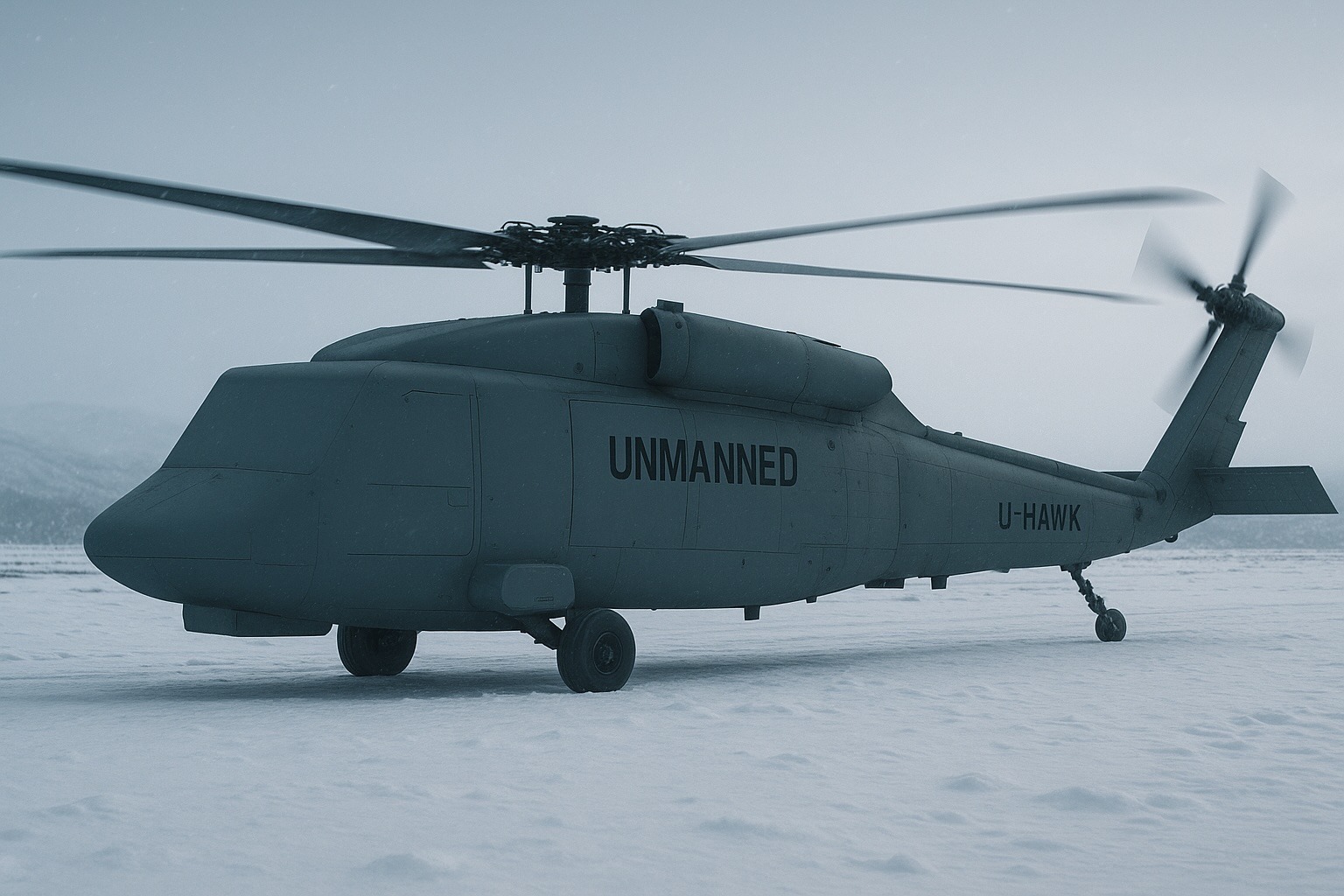
Sikorsky has done something that borders on heresy in aviation circles. They took the Black Hawk, that stoic, battle-tested brute, and quietly deleted the cockpit. No pilots. No seats. No “sorry lads, I think we’re low on fuel.” In their place: a set of actuated clamshell doors and a digital brain called MATRIX (I mean, really?).
The result is the S-70UAS U-Hawk, a fully autonomous Group 5 utility aircraft that can fly, land, and lift without the human drama. It’s effectively a Black Hawk that ghosts its pilots mid-sentence, and that’s precisely the point.
By ripping out the front seats, Sikorsky gained roughly 25 per cent more cargo space. That’s not just a design choice, that’s a statement. The U-Hawk can now swallow HIMARS rockets, uncrewed ground vehicles, or whatever else the Pentagon wants to drop into a contested zone without sending another pilot home in a flag-draped box.
The key trick isn’t the hardware, though, it’s the retrofitting philosophy. Instead of waiting decades and billions for a “next-gen” aircraft, Sikorsky just hacked the existing UH-60 fleet. It’s the military equivalent of slapping self-driving tech on a Ford Escort and calling it an Uber prototype. Cheap, scalable, and instantly operational.
In under ten months, the U-Hawk went from concept sketch to reality. In Pentagon time, that’s about as long as it usually takes to approve a new logo.
Brains That Don’t Blink
At the heart of it all is Sikorsky’s MATRIX autonomy stack, a low-cost, fly-by-wire nervous system that does everything short of asking for leave. The system plans its own routes, recognises obstacles, and adapts mid-flight when the environment turns apocalyptic. It’s SAE Level 4 autonomy, meaning it can handle almost everything on its own, except the paperwork.
What’s unsettling (and quietly thrilling) is that this isn’t some fragile tech demo. MATRIX has already pulled off fully autonomous missions from take-off to shutdown. It doesn’t wait for GPS, it doesn’t panic in degraded conditions, and it doesn’t get distracted by in-flight selfies.
With its 14-hour loiter capability and a 10,000-pound payload, the U-Hawk doesn’t so much replace pilots as make them redundant in the most polite, algorithmic way possible.
Removing the human element from aviation isn’t just safer, it’s cheaper. Training pilots is expensive; keeping them alive is pricier still. Every cockpit comes with life-support, crash cages, and air-conditioning for fragile carbon-based organisms. The U-Hawk skips all that.
Operating costs fall through the floor. Maintenance schedules simplify. The Department of Defense can now imagine a logistics fleet that flies through flak zones, drops supplies, and returns for more, all without needing a morale officer or a canteen.
And because these machines can be refitted from existing UH-60 airframes, the upgrade path looks more like a software rollout than a weapons programme. It’s a logistical revolution disguised as a recycling project.
The Sky Gets Crowded, and Smarter
Competitors are scrambling. Kaman’s KARGO can lift about 1,000 lbs. Phenix’s Ultra 2XL promises modularity and buzzwords. The U-Hawk, meanwhile, quietly hauls ten times that and still lands on a postage stamp. It’s already positioned for the NATO Next-Generation Rotorcraft programme, meaning this isn’t just a one-off stunt, it’s the blueprint for autonomous heavy-lift fleets across allied forces.
In war zones that increasingly punish human presence, a fleet of U-Hawks could sustain dispersed units far beyond traditional logistics range. Think of them as flying pack mules with PhDs in route optimisation.
Safety, or Something Like It
Autonomy’s biggest sales pitch is safety. Remove the tired, overworked human from the loop, and you remove the biggest statistical cause of aviation accidents, us.
Of course, the data isn’t entirely clean. The U.S. Army has found that UAS mishaps actually rise as deployment scales up, not because drones are reckless, but because the humans on the ground managing them are. In other words: we’ve simply moved the cockpit anxiety from the sky to a desk in Nevada.
The real risks now come from cyber intrusion and the non-deterministic logic of AI. The U-Hawk’s digital brain may one day need to prove to regulators that its decision-making is not only explainable but legally defensible, something humans still struggle with after every crash investigation.
Until certification standards evolve beyond the painfully slow DO-178C Level A framework, full civilian autonomy remains grounded in bureaucracy, not physics.
Will Humans Ever Fly Again?
For now, yes. But the writing’s on the hangar wall. The U-Hawk signals the beginning of the end for compulsory pilots, not for human control itself. Manned-Unmanned Teaming (MUM-T) doctrine ensures that while the machines do the dirty work, the humans still sign the authorisation forms and the liability waivers.
As much as we’d like to imagine a future where aircraft decide their own flight paths, the legal system hasn’t caught up. The Pentagon still insists on “meaningful human control” before anything explosive leaves a drone’s belly. The lawyers will be the last to surrender.
But make no mistake, this is a hinge moment. The U-Hawk isn’t a concept; it’s an operational statement. The military now has a workhorse that never eats, sleeps, or demands hazard pay.
And once that efficiency takes root in logistics, the same principle will inevitably seep into civilian flight. Pilots will become supervisors. Supervisors will become passengers. Passengers will… still complain about legroom.
The Verdict
The S-70 U-Hawk isn’t the end of manned aviation. It’s the end of aviation that needs men.
Sikorsky has effectively launched the first true autonomous warbird, one that might out-fly, out-think, and out-survive anything still using fingers and nerves. The skies are getting smarter. The machines are no longer asking for permission.
They already have clearance to take off.